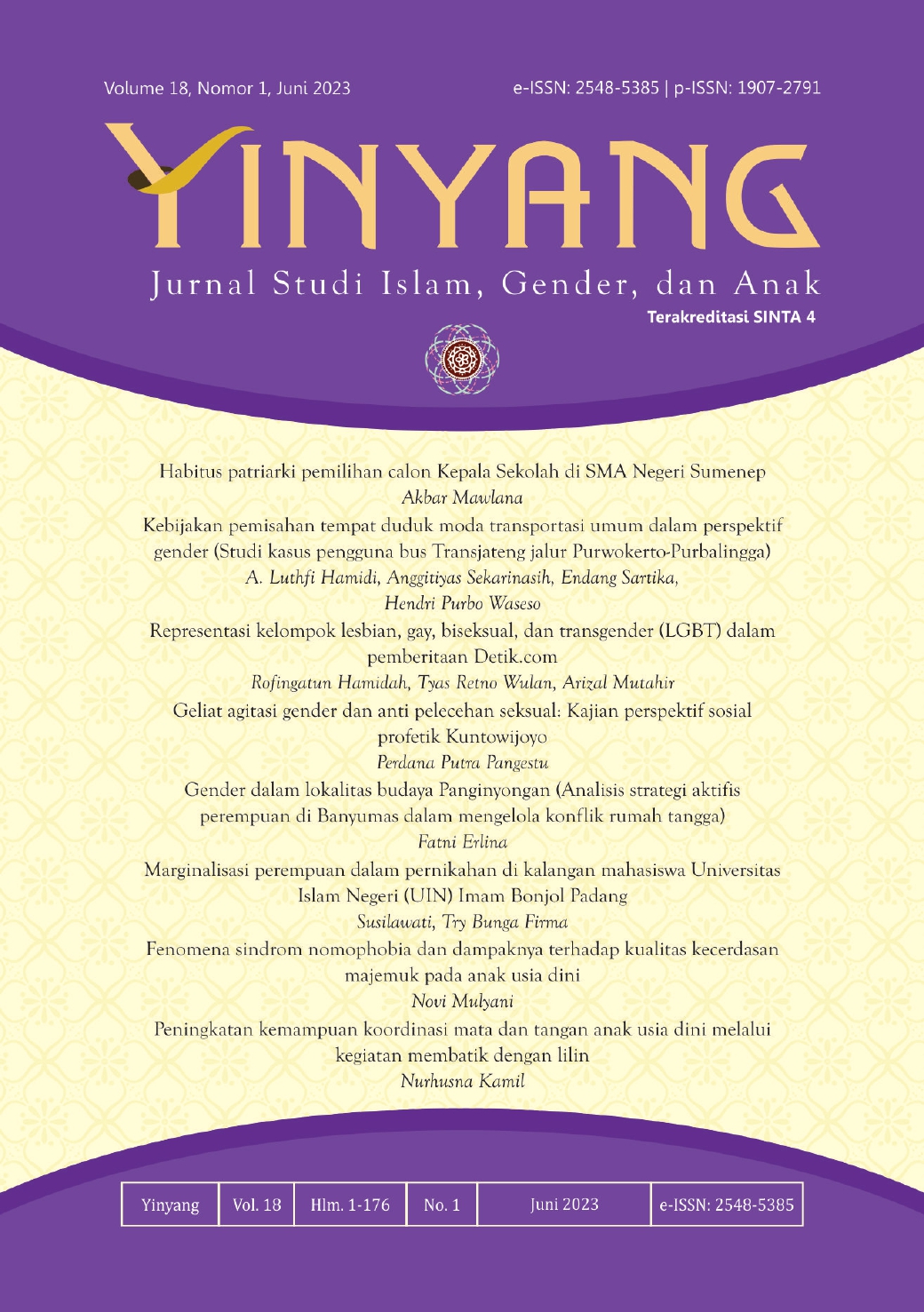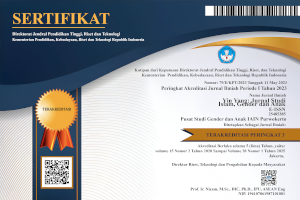Geliat agitasi gender dan anti pelecehan seksual: Kajian perspektif sosial profetik Kuntowijoyo
DOI:
https://doi.org/10.24090/yinyang.v18i1.6803Keywords:
construction of social movements, gender agitation, sexual harassment, social propheticAbstract
Sexual harassment and violence seem taboo and have not been properly internalized in the social area of our society. The popularity of cases that seem to be constantly appearing in the eyes of the public has formed a massive collective agitation to crush the naughty sexual paradigm. The author is interested in studying how movements and counter-narratives are constructed to realize freedom and understanding related to sexual harassment. The author takes a qualitative approach through a literature review and existing phenomena. The description of the study will be obtained by optimizing the formulation of the interpretation of the topic surrounding the issue of sexual harassment. The interpretation and data elaboration were then analyzed using Kuntowijoyo's Social Prophetic theoretical line. This research concludes that various forms of agitation are exposed as exposures in building the value of humanization and liberation for all people fairly and safely.Downloads
References
Armstrong, E. A., Gleckman-Krut, M., & Johnson, L. (2018). Silence, Power, and Inequality: An Intersectional Approach to Sexual Violence. Annual Review of Sociology, 44, 99–122.
Aslamiah, R., & Pinem, M. L. (2020). Kejahatan Sunyi: Potret Pelecehan Seksual Buruh Perempuan. Jurnal Sosiologi USK (Media Pemikiran & Aplikasi), 14(1).
Asmida, E. (2020). Perlawanan Terhadap Dominasi Patriarki Dalam Novel Nyai Gowok dan Kembang Turi Karya Budi Sardjono: Kajian Feminis Radikal. Lakon: Jurnal Kajian Sastra Dan Budaya, 9(2), 71–92.
Bennett, S., Banyard, V. L., & Garnhart, L. (2014). To Act or Not to Act, That is the Question? Barriers and Facilitators of Bystander Intervention. Journal of Interpersonal Violence, 29(3), 476–496.
Bogen, K. W., Bleiweiss, K., & Orchowski, L. M. (2019). Sexual Violence is #NotOkay: Social Reactions to Disclosures of Sexual Victimization on Twitter. Psychology of Violence, 9(1), 127.
Dewi, I. A. A. (2017). Catcalling: Candaan, Pujian atau Pelecehan Seksual. Acta Comitas, 4(2), 198–211.
El Moghrabi, H. (2015). Acceptance in Blame: How and Why We Blame the Victims of Street Harassment. Behavioural Sciences Undergraduate Journal, 2(1), 74–83.
Fahlberg, A., & Pepper, M. (2016). Masculinity and Sexual Violence: Assessing the State of the Field. Sociology Compass, 10(8), 673–683.
Fanaqi, C. (2019). Kritik terhadap konstruksi budaya patriarki melalui karya sastra. Jurnal Komunikasi Universitas Garut: Hasil Pemikiran Dan Penelitian, 5(2), 304–316.
Farid, M. R. A. (2019). Kekerasan terhadap Perempuan dalam Ketimpangan Relasi Kuasa: Studi Kasus di Rifka Annisa Women’s Crisis Center. Sawwa: Jurnal Studi Gender, 14(2), 175–190.
Gelfand, M. J., Fitzgerald, L. F., & Drasgow, F. (1995). The Structure of Sexual Harassment: A Confirmatory Analysis Across Cultures and Settings. Journal of Vocational Behavior, 47(2), 164–177.
Henry, N., & Powell, A. (2015). Beyond the ‘Sext’: Technology-Facilitated Sexual Violence and Harassment Against Adult Women. Australian & New Zealand Journal of Criminology, 48(1), 104–118.
Hinson, L., Mueller, J., O’Brien-Milne, L., & Wandera, N. (2018). Technology-facilitated gender-based violence: What is it, and how do we Measure it?
Jannah, P. M. (2021). Pelecehan Seksual, Seksisme dan Bystander. Psikobuletin: Buletin Ilmiah Psikologi, 2(1), 61–70.
Kuntowijoyo. (1991). Paradigma Islam: Interpretasi Untuk Aksi. Mizan.
Kuntowijoyo. (2007). Islam Sebagai Ilmu: Epistemologi, Metodologi dan Etika. Tiara Wacana.
Maliki, D. N., & Susanti, S. (2019). Komunikasi Persuasif Dalam Kampanye Anti-Kekerasan Seksual Oleh Komunitas Lentera SINTAS Indonesia. Jurnal Komunikasi Dan Bisnis, 7(1).
Perempuan, K. (2021). Perempuan Dalam Himpitan Pandemi: Lonjakan Kekerasan Seksual, Kekerasan Siber, Perkawinan Anak, Dan Keterbatasan Penanganan Ditengah Covid-19. Catatan Tahunan.
Ratnasari, E., Sumartias, S., & Romli, R. (2020). Penggunaan Message Appeals dalam Strategi Pesan Kampanye Anti Kekerasan Berbasis Gender Online. Jurnal Ilmu Komunikasi, 18(3), 352–370.
Sari, W. P., & Savitri, C. B. (2019). Kampanye Komnas Perempuan Pada Kampanye 16 Hari Anti Kekerasan Terhadap Perempuan. Communicology: Jurnal Ilmu Komunikasi, 7(2), 136–150.
Stop Street Harassment. (2014). Unsafe and Harassed in Public Spaces. A National Street Harassment Report.
Suprihatin, S., & Azis, A. M. (2020). Pelecehan Seksual Pada Jurnalis Perempuan di Indonesia. Palastren: Jurnal Studi Gender, 13(2), 413–434.
Tamara, A. L., & Budyatmojo, W. (2019). Kajian Kriminologi Terhadap Pelaku Pelecehan Seksual yang Dilakukan oleh Wanita Terhadap Pria. Jurnal Hukum Pidana Dan Penanggulangan Kejahatan, 5(3), 311–330.
Turchik, J. A., Hebenstreit, C. L., & Judson, S. S. (2016). An Examination of the Gender Inclusiveness of Current Theories of Sexual Violence in Adulthood: Recognizing Male Victims, Female Perpetrators, and Same-Sex Violence. Trauma, Violence, & Abuse, 17(2), 133–148.
Walton, K. A., & Pedersen, C. L. (2021). Motivations Behind Catcalling: Exploring Men’s Engagement in Street Harassment Behaviour. Psychology & Sexuality, 1–15.
Downloads
Published
How to Cite
Issue
Section
License
Copyright (c) 2023 Perdana Putra Pangestu

This work is licensed under a Creative Commons Attribution-ShareAlike 4.0 International License.
Authors who publish with this journal agree to the following terms: Authors retain copyright and grant the journal right of first publication with the work simultaneously licensed under a Creative Commons Attribution-ShareAlike 4.0 International License that allows others to share the work with an acknowledgment of the work's authorship and initial publication in this journal.


















